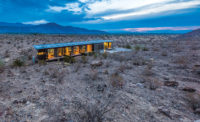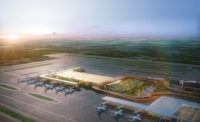There are few urban environments where the lighting is as brash and in-your-face as the Las Vegas Strip, as Philadelphia architect Denise Scott Brown has famously observed (see page 74). Getting a building noticed amid the area’s flashing neon lights and digital screens without shouting just as loud would seem almost impossible. But that is what the lighting designers set out to do at CityCenter, the Strip’s new $8.5 billion mixed-use complex.
The centerpiece of the complex, the Pelli Clarke Pelli—designed Aria Resort & Casino, arguably makes the boldest lighting statement of any of the CityCenter projects. At more than 6 million square feet, it is the development’s largest structure and the only one with a definitive crown. Each of the hotel’s primary wings, a pair of curved glass-clad towers that form intersecting arcs in plan, has an approximately 40-foot-tall series of horizontal, 14-foot-long, finlike aluminum louvers that conceal elevator overruns and other equipment. As part of the lighting scheme by Brandston Partnership, this Modernist cornice is illuminated with asymmetrical fluorescent uplights mounted at the end of each fin. The location of the fixture makes one end of the fin brighter than the other, reinforcing the rhythm of the architecture.
Below the crown, on the roof of the Aria’s vast podium, the lighting designers placed narrow beam floodlights to illuminate the rest of the facade. The fixtures are positioned so that the undersides of perforated shades projecting from the top of each floor catch the light, making the shades glow.
The approach to illuminating the 1,500-room Vdara Hotel, designed by Rafael Viñoly Architects, was similar to that of the Aria, but tailored to its unique form. The building doesn’t have a crown, but is instead a 57-story volume extruded from three overlapping curved bands. In elevation, the Vdara’s architects articulated the three elements with two colors of spandrel glass: white for the outer two and black for the one in between. They also differentiated the spandrel and vision panels by making the vision glazing jut out a few inches from the facade. The lighting designers from Cline Bettridge Bernstein took advantage of this configuration, mounting floodlights on a pool deck and rear podium, so that the protruding edges would reflect light on areas with white glazing. “We illuminated the volumes that would take light the best,” explains Francesca Bettridge, Cline Bettridge Bernstein principal.
For Veer, twin 500-foot-tall condominium towers designed by Murphy/Jahn, the illumination makes the most of the buildings’ defining characteristic: They lean 5 degrees at opposing angles. The lighting, executed by Illuminating Concepts from a scheme by Paris-based Yann Kersalé, includes LEDs mounted on the corners of exterior shading devices to emphasize the tilt.
The lighting design teams weren’t only focused on the view of CityCenter from afar, but also on the experience of those arriving by car or approaching on foot. To light two sweeping laminated-glass entry canopies at the Aria, designers chose warmer lamp sources than those used for the facade. They selected through-canopy downlights with 3000K metal-halide lamps but chose cooler 4000K floodlights to accentuate the towers’ projecting shades. The Vdara has a more solid canopy, but the lamp selection strategy was the same: Sources for illuminating elements near the ground were chosen on the basis of what would be comfortable for people, says Bettridge.
What it is like to stand right next to a structure at night was also a key concern for Focus Lighting, the firm that devised the illumination scheme for Crystals, Daniel Libeskind’s shopping mall. The 500,000-square-foot stainless-steel-clad building, which sits directly on the Strip, features canted and angular planes, leaning toward and away from the sidewalk. Focus sought to soften the pedestrian experience with 39-watt metal-halide uplights placed at the building’s base. Like stage footlights, they provide a soft glow from below. Focus also hid higher-wattage spotlights in planters several feet away to play up particular edges and surfaces of the facade.
One surprising aspect of Crystals is the way its skin reflects the vibrant light and color from signage across the Strip, helping it, at least at night, fit in with CityCenter’s more flamboyantly illuminated neighbors. “The building,” says Focus principal Paul Gregory, “reflects what’s going on in Vegas without actually becoming it.”
PeopleDesign Architects: Pelli Clarke Pelli (Aria Resort & Casino); Rafael Viñoly Architects (Vdara Hotel); Studio Daniel Libeskind (Crystals); Kohn Pedersen Fox (Mandarin Oriental) Exterior Lighting design: Illuminating Concepts (executive lighting design) — Kelly Stechschulte, project manager; Brandston Partnership (Aria Resort & Casino) — Scott Matthews, John Newman, Sanchai Kornwattananon, Napee Deephanphongs, project team; Cline Bettridge Bernstein (Vdara Hotel) — Francesca Bettridge, Michael Hennes, Sang Lee, Chi Iamsakul, project team; Focus Lighting (Crystals and hardscape design) — Paul Gregory, Juan Pablo Lira, Michael Cummings, Stephanie Daigle, Hilary Manners, project team; Yann Kersalé (Veer, conceptual); Isometrix (Mandarin Oriental Hotel, conceptual) |
|
ProductsExterior fixtures: We-ef; Bega; BK Lighting; Edison Price; Color Kinetics; Hydrel; Elliptipar; Erco; Hunza Lamps: Osram Sylvania; Philips; GE LED |








